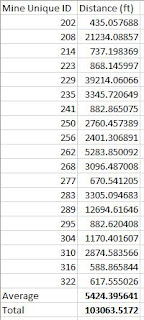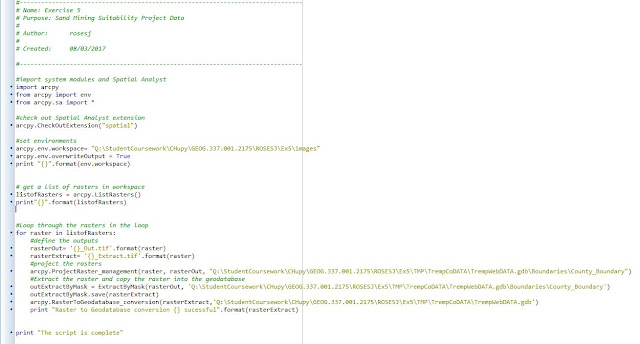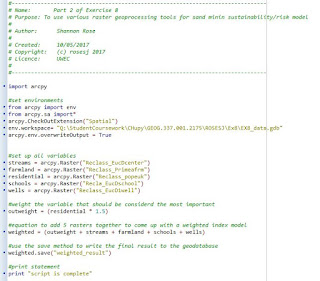This lab worked to build models for frac sand mining suitability and frac sand mining impact for Trempealeau County, WI by using a variety of raster geoprocessing tools. The two models were then overlaid to determine the best overall locations for frac sand mines in Trempealeau County. The impact of sand mining was assessed based on the environmental and cultural risk it poses to Trempealeau County. A viewshed was also created of a popular bike trail in the county to see what areas of the county are visible from the trail. For this lab only the southern half of the county was analyzed for the model due to data size limitations.
Objectives
The lab was split up into 3 different parts to fulfill 15 objectives:
Frac Sand Mining Suitability Model
- Find suitable land for the geologic criteria.
- Find suitable land for the land use criteria.
- Find suitable land for the proximity to railroads criteria.
- Find suitable land for the slope criteria.
- Find suitable land close to water table depth.
- Calculate the index model for the land suitability model.
- Remove the exclusion class from the suitability model.
Frac Sand Mining Community Impact Model
- Determine impact by assessing proximity to streams.
- Determine the impact to prime farmland.
- Determine the impact to residential areas.
- Determine the impact to school locations.
- Determine the impact to wells nearby.
- Calculate overall community impact.
- Determine visibility from a popular bike trail.
Combining Models for Final Best Frac Sand Mining Locations
- Overlay the results to determine the overall best locations in the county for frac sand mines.
All of the data sources were downloaded from online databases. The National Land Cover database and county DEM was downloaded from the USGS National Map Viewer website. Many shapefiles and general data on the county was from the Trempealeau County Land Records file geodatabase. The rail terminals were from the National Transportation Atlas Database from the US Department of Transportation. GIS coverage data files on water table depth were downloaded from the Wisconsin Geological & Natural History Survey website. Reference Gathering Data for Sand Mining Suitability Project previous blog post for more details on the data used for this project.
Methods
For this lab only the southern half of Trempealeau County was assessed for frac sand mining operation locations. A shape file was created of the boundary of the county that would be worked with. In the environmental settings within ArcMap this boundary was set as the mask. A 30 x 30 resolution was used in all raster processing.
Frac Sand Mining Suitability Model
The first part of this lab looked at the landscape of the county and determined what land features are the most suitable and least suitable for frac sand mine placement. The mine would have to be located on a geological formation desirable for frac sand mining, the Wonewoc or Jordan formation. A location close to a rail terminal, with a relatively low slope, close to the water table so the sand can be easily washed after extraction, and on land that has not been developed or too wet or marshy for a mining operation. An exclusion raster was made to exclude developed areas or water filled areas like open water and marshes. Figure 1 shows the ranking scale used during the reclassify operation for each raster. The higher the rank value the more suitable the land is for a frac sand mining operation. Figure 2 explains what ranking was given to each attribute within the various rasters used.
 |
| Figure 1. Ranking scale used to assess land suitability for frac sand mining operations when reclassifying rasters. |
 |
| Figure 2. How rankings for the reclassification of rasters were determined. |
A model was created in model builder to demonstrate the workflow used to create the suitability model for frac sand mining locations in Trempealeau County. This project worked with rasters alone so to begin all of the features being used had be converted to raster format. The Reclassify tool was used to change the values within a raster. The Euclidean Distance tool was used to explain a cell's relationship to a source or more than one source based on a straight-line distance. The Block Statistics tool was used to average slope values to help eliminate the salt and pepper appearance of the slope raster. For the distance to rail terminal analysis a larger processing extent was used because sometimes the closest rail terminal was not in Trempealeau County but in an adjacent county. The model that was created can be seen in Figure 3. The first Raster Calculator equation used added all of the 4 rasters created together. The higher the output value the greater the land suitability for mining in that location. The second Raster Calculator equation multiplied the output of the first raster calculator operation by the exclusion feature class made to exclude completely unacceptable locations for frac sand mining operations.
 |
| Figure 3. Model builder model of the workflow used to create the suitability model for frac sand mining in Trempealeau County. |
Frac Sand Mining Community Impact Model
The second part of this lab looked at the impact a frac sand mine would have on the community in the area it would be placed. The mine would need to be far enough away from a stream as to no cause extra debris to end up in the water flow. To assess this the centerlines, were used as the streams of concern because they represented the main flows of streams and rivers within the county. Mines would have a high impact on a community if they were built on prime farmland. It is not desirable to take away prime farmland to build a frac sand mine. Frac sand mines need to be far enough away from residential areas due to the noise shed created by the mining operation. A mine must be 640 meters away from a residential area according to standard zoning laws. The National Land Cover Database was used to determine residential areas. Any area labeled as developed was considered a residential area for the impact model. A disadvantage of using this methodology is that industrial areas, commercial, and residential areas are not specified by using this methodology. An advantage is that using this method of determining residential areas makes sure to encompass any form of developed area so that it can be guaranteed the 640 meters zoning law is followed, as to all developed areas are represented. The same goes for schools, mining operations should be far enough away from schools as to keep schools a safe area and limit distractions the mining operation might cause for students. The last factor that was assessed was wells, frac sand mining operations should occur far enough away from wells so that no water contamination occurs. Figure 4 shows the ranking scale used during the reclassify operation for each raster. The higher the rank value the less preferable that location is for frac sand mining due to the higher impact that location would have on the community. Figure 5 explains what ranking was given to each attribute within the various rasters used.
 |
Figure 4. Ranking scale used to assess
community impact a frac sand mining
operation would have when
reclassifying rasters.
|
 |
| Figure 5. How rankings for the reclassification of rasters
were determined.
|
A model was created in model builder to demonstrate the workflow used to create the community impact model for frac sand mining locations in Trempealeau County. Much like the model in Figure 3, all datasets were converted to raster format and the Reclassify and Euclidean Distance tools were used to create the model. A viewshed was also created for a popular bike trail in Trempealeau County. The Viewshed tool determines the locations on a raster surface that can be seen from an input feature. A DEM along with the bike path feature were used in the tool so that elevation could be taken into account when considering what might be visible from the bike path feature. The model that was created can be seen in Figure 5. The Raster Calculator equation that was used added all of the rankings of the 5 rasters together. The higher the output value the higher impact a mine would have on the community in that location.
 |
| Figure 5. Model builder model of the workflow used to create the community impact model for frac sand mining in Trempealeau County. |
Combining Models for Final Best Frac Sand Mining Locations
The third part of the lab worked to combine the results of part 1 (suitability model) and part 2 (community impact model). Figure 6 shows the ranking scale used during the reclassify operation for each raster. The higher the rank value the better that location is for frac sand mining and the lower the rank the worse that location is for frac sand mining. Figure 5 explains what ranking was given to each attribute within the various rasters used. Figure 8 is the model that was created in model builder to demonstrate the workflow used to create the final assessment of where frac sand mines should be placed in Trempealeau County. The Raster Calculator equation that was used subtracted the community impact raster from the suitability raster. The higher the output value the better the location is for a frac sand mine.
 |
| Figure 7. How the rankings for the reclassification of the final raster assessment of frac sand mining operations were determined. |
 |
| Figure 6. Ranking scale used to assess the best locations to place frac sand mines when reclassifying the final raster. |
 |
| Figure 8. Model builder model of the workflow used to create the final raster assessment of the best locations for a frac sand mining operation in Trempealeau County. |
Results and Discussion
The results of the suitability model determined that the west central part of the county is generally better for placing a frac sand mine. There are more railroad terminals on the west side of the county. The other factors considered are pretty evenly distributed across the county. There is some discrepancy on the southern portion of the county. The geology type there and landcover exclusion suggest the southern portion is not suitable for frac sand mining, but the slope and ground water depth suggest that this is a good location for a frac sand mine. The results from the suitability model can be seen in Figure 9.
 |
| Figure 9. Results from the suitability model for Trempealeau County, WI. |
 |
| Figure 10. Results from the community impact model for Trempealeau County, WI. |
 |
| Figure 11. Final results for where to place a frac sand mine in Trempealeau County, WI. |
 |
| Figure 12. Viewshed from the Beauty & Diversity Abound bike trail in Trempealeau County. A large portion of the county is visible from the loop this bike trail forms on the east side of the county. |
Conclusions
This lab worked to find good locations in Trempealeau County, WI to place frac sand mines. It is important to consider both land suitability and community impact factors when deciding where to place a frac sand mine. This lab only looked at several factors that could be considered when locating a good location for frac sand mining operations. There are many others that could be considered, like viewsheds from prime recreational areas, parks, or distance from wildlife areas. The models made for this county could be adapted and used by other counties by using different raster data sets. Also the models could be modified based on what characteristics the county finds important for considering different locations for frac sand mining operations.
Sources
GIS data. (n.d.). Retrieved May 16, 2017, from http://wghs.uwex.edu/maps-data/gis-data/.
Land Records. (n.d.). Retrieved March 10, 2017, from http://www.tremplocounty.com/tchome/landrecords/.
National Transportation Atlas Database- Bureau of Transportation Statistics. (n.d.). Retrieved March 10, 2017, from https://www.bts.gov/geospatial/national-transportation-atlas-database.
TNM Download. (n.d.). Retrieved March 10, 2017, from https://viewer.nationalmap.gov/basic/.
Web Soil Survey. Retrieved March 10, 2017, from https://websoilsurvey.sc.egov.usda.gov/App/HomePage.htm.


















